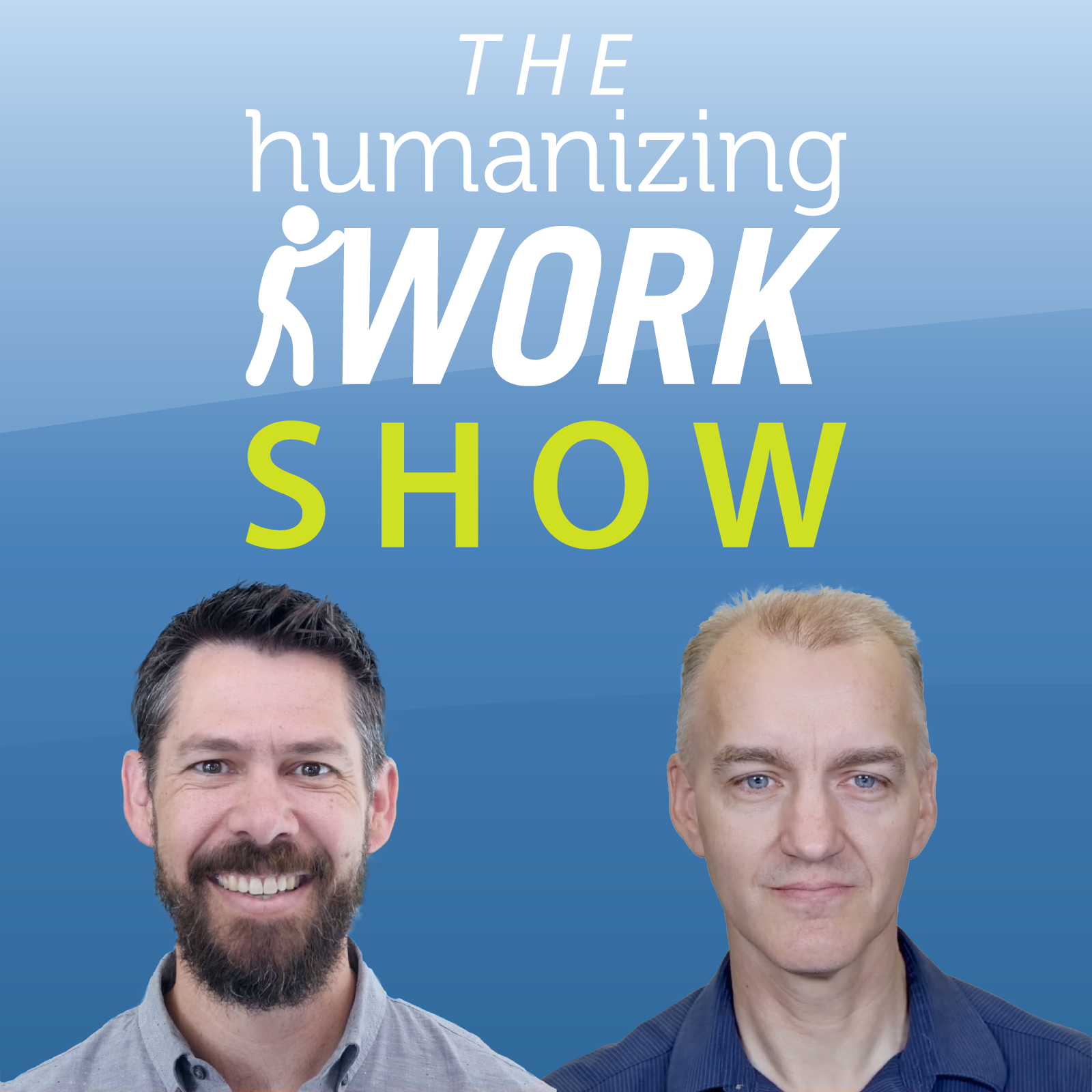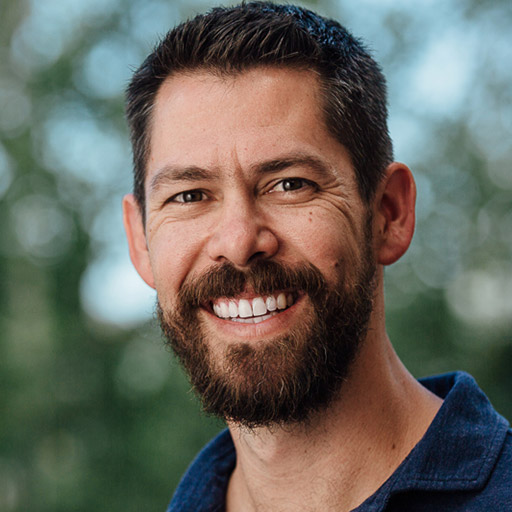Episode Transcript
Peter: Welcome to the Humanizing Work Show. We know you're probably feeling interrupted all the time. Someone sends you a note asking for just a minute of your time to help them out. Or a senior stakeholder drops by with just one quick request. Shouldn't take long.
Or maybe there's a real emergency, what you plan for the day suddenly gets blown up. Maybe someone sent you a link to this episode and said, "you need to watch this right now!" And they were probably right. Or as one client put it, I see you're eating lunch. Clearly you have time to do this for me.
Richard: If you're in that situation, there are three solutions to this that seem attractive but don't actually work.
Number one, hope and denial. It'll probably fit. Uh, just say yes to everything, which, if you have a high capacity, actually works in the short term and can have some positive reinforcing loops, and you can be successful with it until you burn yourself out.
Number two. We just need to make a policy or process about it. But inevitably, there are exceptions that break the policy. And now you're back to, I don't know how to decide and why we said yes to this one and not this other one.
And number three, one we get requests for all the time is, what are the magic words? If I just learned the magic words to say no, everybody will still be happy, even though I'm saying no. And while there are ways into better conversations, and we'll talk about some of them today, there is no avoiding the need for judgment about what to say no to ,and what to say yes
Peter: to. I'm thinking about a real example that happened to me yesterday, Richard. We have a Slack channel that's called #NeedsReview, and as people work on things where they could benefit from a little bit of review, like a newsletter article, or a piece of content for the website, or a course we're working on, we'll ping that channel and say, "Hey, this, this content's done. I could use some review on it."
And I was in the middle of working on some content, when I got a ping from Slack saying, Hey, Richard wants some review on this. And in that moment I had to think, Ugh, I could probably do that and then get back to my thing. But the research shows it's like 23 minutes on average when you get interrupted on, on something that's in your head. Uh, and I thought, I don't know if that's worth it, but I thought, ah, maybe I could do it. So I had a little bit of that hope and denial. Maybe I could just knock this review out in five minutes, get right back to the task I was working on, and then Richard would have feedback sooner in case he was hoping to act on that.
Then I thought, well, maybe Richard and I should have a policy, like when something hits #NeedsReview, the policy is we're gonna review it within that business day. Or if it comes in the morning, we review it by the end of the day, or if it 24 hours or something, some kind of policy.
And then I thought, uh, should I just ping Richard and say, Hey Richard, I'm really sorry, but as you know, I'm working on this other piece for this course that we have coming up. I don't know if I'm gonna get to it in time. And I, I thought, what are the right words to use?
So I could see all three of these playing out in that example yesterday.
Richard: Right. And none of them really solved the problem. So we're, we're gonna get into what does today, and I, I think it's important to set the foundation for this by saying, a no is actually a yes, and a yes is actually a no.
Peter: Hmm. This feels like a Buddhist koan, Richard, something I could meditate on for many years and only get enlightenment if I, if I pondered it enough. Maybe you could clarify how a no is actually a yes and yes is actually a no.
Richard: Okay, every time we say no, we're protecting capacity and focus for something else. And every time we say yes, we are implicitly using capacity and focus that could go elsewhere. There's an opportunity cost, so the way to say yes and no to the right things is actually downstream from clarity about what the right things are. And then once you have that clarity, there are tactics to have better conversations.
Peter: It occurs to me that without that clarity, if you say no, it can just be perceived as you being stubborn, or not a team player, or even playing politics. So in today's episode, we're gonna share five ways to say no more safely and easily. Um, these five techniques lead to better nos, better choices for the business, better choices for the team, better choices for yourself.
And while we're describing these through the lens of business requests for your time, the same tools work for personal requests as well. So, we won't emphasize that in the episode, but you'll see the parallels if you're looking for them.
Richard: Alright, so the first technique is to get clear on your purpose. This can be at any scale. It can be your individual why. It can be your team, why do we exist? It can be your organization or the project that you're working on across multiple teams. When you know why you're doing what you're doing, it's easier to filter what doesn't fit.
But the person coming to you with the interruption often doesn't care about your purpose. They maybe have some other thing you're no longer working on, but you worked on in the past, and they want you to go do something for that. We see this one all the time as old systems live on, and teams get reorganized.
So this one works best when purpose is visible and when purpose is nested. Like, your team's purpose builds up into some larger purpose. And so when somebody comes to you, you can say, you know, show me how this fits into the thing that we're supposed to be doing right now.
So your no doesn't have to be just an outright No. It can be an invitation to find alignment with purpose. And a lot of times what happens is somebody says, you know what? This actually isn't aligned with the thing you're working on right now. I understand why you're saying no, even if I don't like it.
Peter: I've found that, uh, even with a clear personal or team purpose, you're still gonna get those requests from different stakeholders. They're gonna have different competing priorities and goals. And it's a good first filter, but we can have a more granular, specific outcome that we've already done the work to align on with leadership and stakeholders. Something like, uh, the, the current strategy, or our team's OKRs for this quarter, or even a sprint goal. Or for an individual feature, we've done some value modeling and understand what's the economic benefit and what's our theory of impact and what's the urgency profile.
And, um, those can act as a more near term sort of temporary contract. Like, this is what we're committed to right now. And then you can use those same techniques from the section on purpose.
You could say something like, look, we've already aligned on this with other teams and with leadership, and so breaking the contract that I've made with them is a bigger discussion than just you and I. And you can enroll your stakeholders in helping you meet your commitments, rather than putting those commitments at risk.
Richard: Right. And uh, this is a place where just as an aside, smaller slices of value helps a lot. Because it's easier to keep commitments and still make space for responding to change. This is actually one of the reasons we like Scrum. When it's done well, it gives you this nice system for balancing focus in the sprint while having the opportunity to respond to change at sprint boundaries.
And so that brings us to our third technique. You can still get interrupted by purposeful, strategic interruptions, good things that are still interruptions. And so our third technique is more of a not yet than a no.
There's a lot of research that shows that there's value in focus and flow. You are more productive when you're able to focus something and get it all the way done than when you're constantly switching between things.
And so thinking about, uh, how you're going to say, "yes, but not yet" to things is another useful way to say, no, that's important, but not right this second.
And if you've got a, a work system like Scrum, there's a really natural way to do that. That doesn't fit in the sprint, but let's put it in an appropriate place on the backlog and get to it when it's time to focus on that.
Peter: And Scrum gives us another really useful tool for our fourth technique, which is that Scrum calls out the product owner role as the clear decision maker. They're the sole authorizer of work for a Scrum team. So anyone else getting requests can say, well, that sounds really interesting. Let's bring in the product owner. Good product owners should have explicit decision making authority for that.
On Jurgen Appelo's seven levels, which we talk about in episode 67, a product owner should have a level five delegation of decision making, meaning they're gonna seek people's advice, but they own the decision on what happens, at least at the top of the backlog, the next few sprints. Probably further down the backlog as well, depending on how, how things are set up.
Um, and often we find ourselves thinking that we're the decision makers. Maybe somebody told us, Hey, you're empowered! Only to discover that they really own the decision. We're sort of playing what we call empowerment theater. So getting clear on who owns what decision at what level can be really clarifying and allow you to work on what would need to change to push more authority closer to the work that's being done.
Richard: We did an episode a long time ago about dealing with interruptions on the Scrum team. That was kind of a system approach to making that visible. And we'll link to that in the show notes as well. (Ep 68, https://www.humanizingwork.com/dealing-with-interruptions-on-a-scrum-team/)
A fifth technique is related to the interpersonal side of this, how we communicate with each other about our nos, and not yets, even with all the right structures, it's still easy to sound defensive or cold when you're declining a request.
So our last technique here is a mental reframe. It's a change to how you think about and how you express your no. Here's the reframe. See your no as an act of stewardship. You're protecting your capacity, your team's capacity to deliver on your commitments and your purpose.
Back to what I said at the top. A good no to the wrong things is a yes to the right things. There's research around this from Brown and Levinson that showed that even across power gaps, a combination of directness with respect can maintain the relationship. And a sense of purposeful stewardship gives you a way to get both directness and respect.
You might say something like, I understand why you want this thing. But it's important for me to keep my team focused on our strategic purpose, so I need to decline the request or put it further down the backlog or include it in the next release or whatever.
Peter: We've helped leaders improve on all five of these techniques, and if that's something you'd be interested in getting some help with, visit humanizing work.com and hit the contact page. There you can schedule a free call with us to get our advice on how you can get better at saying No without being a jerk.
While you're there, you can check out our workshops, our coaching, and our online courses.
And if you get value from the show and you wanna support it, the best thing you can do if you're watching on YouTube is subscribe like the episode, and click the bell icon to get notified of new episodes and drop us a comment with what you have seen work to say no without being seen as a jerk.
If you're listening on the podcast, a five star review makes a huge difference in whether other people who'd benefit from the show find it or not.
Richard: If you're too busy, and you have to say no to giving us a five star review, i'm sad, but if it means you've got clarity on your purpose, you're focused on your near term commitments, you're protecting your flow, you're exercising decision making authority, and you're stewarding your limited capacity, that's a no we can respect.
Peter: Using any or all of these techniques will help you say no to the wrong things so that you can keep saying yes to the things that really matter. And that's worth a little bit of discomfort as you practice getting better at it. So I hope you'll give it a try.
Richard: Thanks for tuning in. We'll see you next time on the Humanizing Work Show.




